In today's rapidly developing artificial intelligence technology, a unique experiment called the 'Turing Roulette Competition' has quietly concluded. This months-long competition not only showcased AI's astonishing ability to deceive humans but also demonstrated the extraordinary intelligence and adaptability of humans when facing machine challenges. This is not merely a game but an important exploration of the trust mechanisms in the future digital world.

Redefining the Classic Turing Test
The design inspiration for the Turing Roulette Competition comes from the famous Turing Test proposed by the father of artificial intelligence, Alan Turing, but it transforms this classic concept into a more interactive and competitive form. Participants are randomly assigned to chat rooms, where their conversation partners could be either humans or one of today's most advanced AI chatbots. They need to make judgments during the conversation: is the interlocutor AI or human?
The cleverness of this design lies in the fact that it not only tests the participants' ability to recognize AI but also encourages human participants to try to mimic AI behavior patterns to confuse other players. Every correct judgment earns points for players, propelling them up the leaderboard, while incorrect judgments cause them to lose the hard-earned points. This dual challenge mechanism makes the competition particularly engaging.
Astonishing Participation Scale
The final data from the Turing Roulette Competition is impressive: a total of 144,309 unique players participated, making 3,750,223 attempts to judge 'Is this AI or human?' All these interaction records are stored as proofs on the Lagrange network. Such a scale of participation not only reflects the public's concern about AI development but also provides valuable data resources for studying human-machine interaction.
The Exciting Evolution of Three Stages
The competition is divided into three different stages, each with its unique features and challenges. The first season, launched on April 3, 2025, adopted an exclusive invitation code mechanism, attracting 35,517 players to participate in this contest of human and machine intelligence. This restrictive admission method not only ensured the quality of participants but also laid the groundwork for future seasons' expansion.
Immediately following, the second season, which began on April 23, significantly expanded, with 139,059 participants engaging in 1,511,527 games. More importantly, the second season introduced significant game mechanism upgrades: AI chatbots became harder to identify, their conversation styles more diverse and unpredictable, better simulating normal human dialogue patterns. Additionally, players who guessed correctly in succession could earn extra reward points, further enhancing the strategy and challenge of the competition.
The Ultimate Showdown of the TrAItors Tournament
On May 6, the entire competition welcomed the most exciting ultimate showdown—the TrAItors Tournament. This three-day elite event gathered the world's top chatbot recognition experts, who competed fiercely for a substantial prize of over $8,000. Ultimately, 4,988 top competitors engaged in 111,596 duels, demonstrating human excellence in recognizing and responding to AI challenges.
Deeper Meaning: A Warning for the Future of the Internet
The true value of the Turing Roulette Competition far exceeds mere entertainment; it is, in fact, a profound rehearsal for the future digital world. Although today's AI models can pass traditional Turing tests, this competition reveals a more urgent question: in an internet environment lacking verification mechanisms, what challenges and risks will users face?
When we cannot determine whether the other end of an online conversation is human or machine, the foundation of all digital interactions is shaken. This not only affects individual social experiences but could also have far-reaching implications for important areas such as business transactions, academic research, and legal proceedings. The Turing Roulette Competition gamified this experience, allowing participants to personally experience the troubles brought by such uncertainty.
Verifiable AI: The Key to Building a Trustworthy Digital Future
It is precisely based on a deep understanding of this challenge that the Lagrange team developed innovative technologies like DeepProve, dedicated to building verifiable AI systems. The core idea of these technologies is that no one should have to guess whether their interlocutor online is AI or human. Through zero-knowledge proof technology, cryptographic proof of the AI reasoning process can be provided while protecting privacy, thereby establishing a trust mechanism based on proof rather than guesswork.
The application scope of tools like DeepProve goes far beyond chat rooms; they can provide reliable security guarantees for various stages from AI reasoning to model training validation. As AI technology is deeply applied in key areas such as healthcare, finance, education, and transportation, scalable zero-knowledge proof generation technology will become an important guarantee to ensure we are 'under good protection.'
The Victory of Human Intelligence and Future Prospects
The successful hosting of the Turing Roulette Competition proves the adaptability and innovative spirit exhibited by humans when facing AI challenges. Participants not only learned to identify various features and behavior patterns of AI but also developed strategies to cope with different types of machine learning models. This collective learning process itself is a manifestation of human intelligence.
However, this competition also reminds us that relying solely on human recognition abilities to face AI challenges is inadequate. As AI technology continues to advance, the ability of machines to simulate human behavior will only become stronger. Therefore, we need to establish reliable verification mechanisms from a technical standpoint to ensure transparency and credibility in the digital world.
The Turing Roulette Competition is not only an exciting contest of human and machine intelligence but also an important exploration of future digital social governance models. It tells us that in the age of AI, human intelligence remains irreplaceable, but we also need more advanced technological tools to maintain order and trust in the digital world. Through innovative technologies like DeepProve, we can ensure that while enjoying the conveniences brought by AI, we always maintain control, allowing humans to truly be 'under good protection.'

